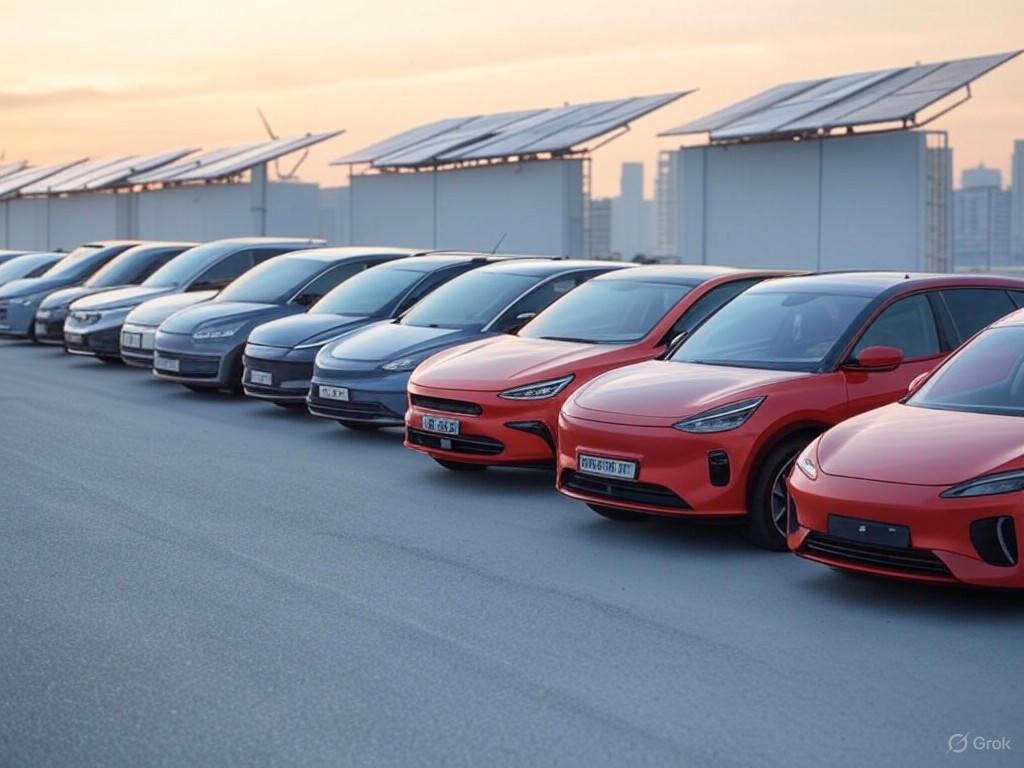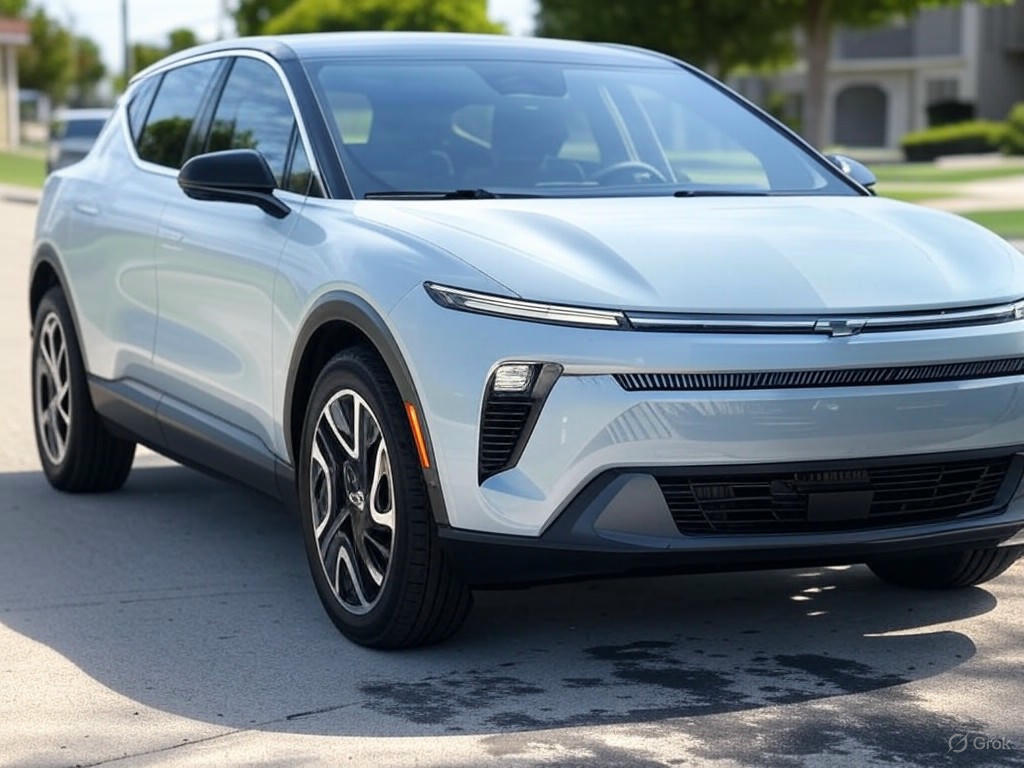
Top 10 Affordable 2025 EVs: Real Range & Price Compared
- Introduction: Why the 2025 Affordable EV Landscape Matters and Selection Criteria
- Introduction: Why the 2025 Affordable EV Landscape Matters and Selection Criteria
- Selection Criteria: Balancing Technical Specs with Real-World Usability
- Why Exclude Ultra-Luxury and Niche EVs?
- Conclusion: Key Takeaways and Contextualizing the 2025 Affordable EV Market
- Conclusion: Key Takeaways and Contextualizing the 2025 Affordable EV Market
- Progress in Price, Range, and Features
- Ongoing Challenges: Infrastructure and Trade-offs
- Buyer Guidance: Prioritizing Specifications Versus Practical Needs
- Looking Ahead: Trends Shaping EV Affordability and Adoption
- Final Thoughts
- 1. Nissan Leaf (2025) – The Veteran Affordable EV with Proven Reliability
- Nissan Leaf (2025) – The Veteran Affordable EV with Proven Reliability
- Updated Specifications: Range, Price, and Charging
- Practical Usability for City and Suburban Drivers
- Limitations and Comparison to Earlier Models
- 2. Chevrolet Equinox EV (2025) – Budget-Friendly SUV with Competitive Range
- Chevrolet Equinox EV (2025) – Budget-Friendly SUV with Competitive Range
- Pricing and EPA Range: Striking a Practical Balance
- Technical Specifications
- Interior and Technology Features
- Real-World Performance and Comfort
- Competitive Positioning
- Final Assessment
- 3. Hyundai Kona Electric (2025) – Compact Crossover with Balanced Performance
- Hyundai Kona Electric (2025) – Compact Crossover with Balanced Performance
- Pricing and EPA Range
- Technical Specs and Driving Dynamics
- Cabin Quality and Practicality
- Reliability and Efficiency Reputation
- Real-World Driving and Charging Insights
- 4. Mini Cooper Electric (2025) – Stylish Urban EV with Agile Handling
- Mini Cooper Electric (2025) – Stylish Urban EV with Agile Handling
- Range, Pricing, and Charging Performance
- Styling and Driving Experience
- Practicality and Limitations
- How It Stacks Up Against Competitors
- Bottom Line
- 5. Hyundai Ioniq 6 (2025) – Streamlined Sedan Combining Range and Value
- 5. Hyundai Ioniq 6 (2025) – Streamlined Sedan Combining Range and Value
- Design and Aerodynamics: Efficiency in Motion
- Pricing, Battery, and Powertrain Details
- Interior Tech, Comfort, and Practicality
- Real-World Efficiency and User Experience

Introduction: Why the 2025 Affordable EV Landscape Matters and Selection Criteria
Introduction: Why the 2025 Affordable EV Landscape Matters and Selection Criteria
Affordable electric vehicles (EVs) in 2025 have transitioned from niche offerings to pivotal players in the overall automotive market. Over the past decade, battery costs have dramatically declined, with Goldman Sachs projecting prices to fall to around $80 per kWh by 2026. This substantial reduction is reshaping global pricing strategies, especially as Chinese manufacturers aggressively introduce competitive models into the mainstream U.S. market. Consequently, EVs priced under $45,000 MSRP are increasingly accessible to typical buyers, expanding electric mobility beyond early adopters and luxury segments.
Market data reinforces this trend: the U.S. recorded a historic 1.3 million EV sales in 2024, marking a 7.3% increase from the previous year. Forecasts from Cox Automotive suggest that by the end of 2025, up to one in four vehicles sold in the U.S. could be electrified. Despite challenges such as tightened federal tax credit eligibility and potential tariffs on raw materials, consumer interest remains robust. Tesla continues to dominate nearly half of EV sales, largely thanks to its Supercharger network, which sets the standard for public charging convenience and user satisfaction.
Selection Criteria: Balancing Technical Specs with Real-World Usability
Our evaluation of the top affordable EVs in 2025 begins with price, focusing on models with a Manufacturer’s Suggested Retail Price (MSRP) typically below $45,000. This threshold aligns with federal tax credit caps and reflects mainstream consumer expectations for affordable EVs.
Range is a critical factor, but real-world usability requires nuance beyond EPA estimates. While EPA-rated ranges provide a standardized baseline, independent testing and user reports often reveal discrepancies. For instance, Edmunds’ conservative range tests—which emphasize city driving and controlled climate conditions—frequently show significant differences compared to EPA figures. We prioritize models with EPA-rated ranges generally exceeding 200 miles, giving additional weight to those that reliably meet or surpass these claims in everyday driving scenarios.
Charging capability significantly impacts ownership experience. Access to fast DC charging, compatibility with widespread networks—including Tesla’s increasingly accessible Supercharger system—and onboard charging power all influence usability. Our assessments consider charging speed, connector standards, and network availability, recognizing that charging infrastructure remains a practical barrier for many EV buyers.
Finally, overall value is paramount. The ideal affordable EV strikes a balance among price, range, charging convenience, build quality, and reliability, all while delivering strong user satisfaction. Studies indicate that affordable EVs often feature fewer complex or experimental technologies than luxury models, which can translate into greater reliability and higher owner satisfaction.
Why Exclude Ultra-Luxury and Niche EVs?
This list intentionally excludes ultra-luxury and niche electric vehicles, such as the BMW iX or Audi e-tron GT. While these models boast cutting-edge technology and extended ranges, their price points far exceed those of mainstream buyers. Including them would dilute the focus on affordability and everyday practicality.
Our emphasis is on EVs that deliver dependable daily transportation without premium features that escalate cost and complexity. Mainstream affordable EVs are closing the satisfaction gap with luxury models by offering simpler, more reliable designs and better integration with existing charging infrastructure. This democratization ensures that solid electric driving experiences are accessible without a luxury price tag.
By concentrating on affordable, well-rounded EVs, this article serves consumers seeking a practical blend of price, range, and real-world usability—free from luxury branding distractions or niche market gimmicks. This approach reflects the evolving market reality, where affordability and practicality are key drivers of EV adoption, supported by maturing technology that makes electric vehicles genuinely accessible to the masses.
Conclusion: Key Takeaways and Contextualizing the 2025 Affordable EV Market
Conclusion: Key Takeaways and Contextualizing the 2025 Affordable EV Market
The affordable electric vehicle (EV) market in 2025 marks a significant evolution from just a few years ago. Buyers now enjoy a diverse selection of EVs that offer a practical balance of price, driving range, and features, making electric mobility increasingly accessible to mainstream consumers.
Progress in Price, Range, and Features
One of the most remarkable advances is the availability of longer driving ranges at more affordable price points. Take, for example, the Chevrolet Equinox EV, which delivers over 300 miles of real-world range for under $40,000—a milestone that was nearly unattainable in earlier budget EVs. Likewise, models like the Hyundai Kona Electric and Volkswagen ID.4 provide competitive EPA-rated ranges between 220 and 300 miles, combined with user-friendly technology and standard DC fast charging capabilities.
Beyond range improvements, 2025 EVs come equipped with enhanced tech features. The Hyundai Ioniq 6, for instance, boasts aerodynamic efficiency paired with an 800V charging architecture, which enables faster recharge times and better energy utilization. Many models also include semi-autonomous driving aids, advanced infotainment systems, and seamless smartphone integration, raising the bar for affordable EVs’ usability.
However, entry-level EVs such as the Nissan Leaf still present trade-offs. The Leaf’s shorter range of about 149 miles and adherence to the legacy CHAdeMO charging standard limit charging convenience and future-proofing, especially compared to CCS1-equipped competitors.
Ongoing Challenges: Infrastructure and Trade-offs
Despite clear progress, several challenges persist. While the charging infrastructure is expanding rapidly—with over 134,000 Level 2 public chargers and 44,000 DC fast chargers across the U.S.—coverage remains uneven, particularly in rural and less populated areas. Ultra-fast chargers capable of delivering 350 to 400 kW cut charging times to roughly 20 minutes for an 80% battery refill, but their availability outside urban centers is still limited.
Range anxiety continues to be a practical concern, especially in colder climates where battery efficiency can drop between 10% and 30%. Additionally, some affordable EVs sacrifice vehicle size, interior space, or performance to maintain competitive pricing. For example, the Mini Cooper Electric shines with its agile handling and distinctive style but offers a modest range and limited cargo space compared to larger SUVs like the Equinox EV or Volkswagen ID.4.
Buyer Guidance: Prioritizing Specifications Versus Practical Needs
Prospective EV buyers should align their choice of vehicle with real-world usage rather than focusing solely on headline specs. Consider the following factors:
-
Range Requirements: Evaluate your daily commute distance and home charging access. Urban drivers with shorter daily trips may find a 200-mile range sufficient, while those frequently traveling longer distances should prioritize EVs offering 300+ miles.
-
Charging Infrastructure: Assess the availability and compatibility of fast chargers along your typical routes. Favor models supporting CCS1 fast charging, given its dominance in North America and faster charging speeds compared to legacy standards like CHAdeMO.
-
Feature Priorities Versus Budget: If advanced driver assistance, spacious interiors, or premium infotainment are important, be prepared for a slightly higher budget or consider models such as the Volkswagen ID.4 or Hyundai Ioniq 6. For budget-conscious buyers, the Chevrolet Equinox EV offers a commendable balance of range, features, and price.
-
Warranty and Reliability: Investigate warranty coverage and real-world reliability data. Models like the Hyundai Kona Electric, while well-regarded, are reaching maturity and may warrant additional scrutiny regarding maintenance and support.
Looking Ahead: Trends Shaping EV Affordability and Adoption
The outlook beyond 2025 is optimistic for further improvements in EV affordability and technology. Battery costs, which have already plummeted over the past decade, are projected by Goldman Sachs to decline to around $80 per kWh by 2026. This cost reduction will likely translate into either lower vehicle prices or increased driving ranges at the same price point.
Emerging battery chemistries such as solid-state and lithium-sulfur promise faster charging, enhanced safety, and longer lifespans. On the infrastructure front, the proliferation of ultra-fast charging networks, exemplified by providers like Electra offering chargers exceeding 400 kW, will reduce downtime during travel. Innovations like wireless charging pads and vehicle-to-grid (V2G) technology could add new layers of convenience and economic value, offering owners opportunities to support grid stability and even generate revenue.
Global competition, notably from Chinese manufacturers who dominate both EV sales and battery technology development, will continue to pressure automakers worldwide to innovate and reduce costs. Government incentives, expanding public charging networks, and improved battery warranties are key factors that will accelerate mainstream EV adoption.
Final Thoughts
In practical terms, 2025 offers some of the best value propositions in affordable EVs to date. Buyers who thoughtfully navigate trade-offs—balancing driving range, charging access, and features against price—can find electric vehicles that satisfy everyday needs without the premium price tag of luxury models.
However, switching to an EV requires informed decisions grounded in realistic expectations about range, charging logistics, and vehicle usability. As battery technologies mature, charging infrastructure expands, and pricing becomes more competitive, electric vehicles are poised to become the sensible default choice for an increasingly broad spectrum of drivers.
This democratization of electric mobility reflects a pivotal moment: affordable EVs are no longer just a niche alternative but a compelling, practical option for the mainstream market.
| Model | Real-World Range (miles) | Price (USD) | Charging Standard | Notable Features |
|---|---|---|---|---|
| Chevrolet Equinox EV | 300+ | Under $40,000 | CCS1 | Over 300 miles range, good balance of features and price |
| Hyundai Kona Electric | 220-300 (EPA-rated) | Affordable | CCS1 | Competitive range, user-friendly tech, DC fast charging |
| Volkswagen ID.4 | 220-300 (EPA-rated) | Affordable | CCS1 | Competitive range, spacious interior, advanced features |
| Hyundai Ioniq 6 | Not specified | Higher budget | CCS1, 800V charging | Aerodynamic, fast charging architecture, semi-autonomous aids |
| Nissan Leaf | About 149 | Entry-level affordable | CHAdeMO | Shorter range, legacy charging standard |
| Mini Cooper Electric | Modest (not specified) | Affordable | Not specified | Agile handling, limited cargo space and range |
1. Nissan Leaf (2025) – The Veteran Affordable EV with Proven Reliability
Nissan Leaf (2025) – The Veteran Affordable EV with Proven Reliability
The 2025 Nissan Leaf remains a stalwart in the affordable EV segment, offering a dependable and budget-friendly option for entry-level buyers. With a starting MSRP of $28,140 for the base S trim and $36,190 for the SV Plus, it delivers essential electric driving capabilities without excessive cost, making it one of the lowest total cost of ownership EVs in the U.S.
Updated Specifications: Range, Price, and Charging
The 2025 Leaf is offered in two main trims:
- Leaf S: This model comes with a 40 kWh battery pack, providing an EPA-estimated range of about 149 miles.
- Leaf SV Plus: Equipped with a larger 60.55 kWh battery, it extends the EPA range to approximately 212 miles.
While these ranges are modest compared to newer competitors that often exceed 250 miles, the Leaf’s range adequately covers most daily urban and suburban driving needs. This makes it a practical choice for commuters and city drivers who rarely require long-distance travel.
Regarding charging, the Leaf continues to use the CHAdeMO DC fast charging standard. However, CHAdeMO is increasingly considered outdated in North America, where the CCS1 standard dominates. CHAdeMO’s slower charging speeds mean longer stops during fast charging, which can be a limitation for long-distance trips. For most users, home charging remains the primary method, with Level 1 (110-120V) and Level 2 (240V) chargers. Level 2 charging typically replenishes the battery in a few hours, fitting well with overnight charging routines.
Practical Usability for City and Suburban Drivers
The 2025 Leaf excels in everyday usability, particularly for city residents and suburban commuters:
- Its compact hatchback form offers comfortable seating for five and practical cargo space, supporting daily errands and modest family needs.
- Nissan’s advanced driver assistance technologies, including ProPILOT Assist, Safety Shield 360, and Intelligent Driver Alertness, enhance safety and ease the driving experience, especially in stop-and-go traffic.
- The one-pedal driving experience via the e-Pedal system simplifies urban driving, making it intuitive to accelerate and brake in heavy traffic.
- The NissanConnect® EV app enables remote control features such as climate preconditioning, door locking, and charging status monitoring, adding convenience and control.
In real-world conditions, the Leaf delivers responsive acceleration thanks to instant electric torque, coupled with a low center of gravity that promotes stable handling. Owner feedback consistently highlights the vehicle’s reliability and user-friendly operation, especially when primarily charged overnight at home.
Limitations and Comparison to Earlier Models
The Leaf’s primary trade-off is its limited range, which falls short when compared to newer affordable EVs offering more than 250 miles per charge at similar or slightly higher prices. This gap may influence buyers who frequently undertake longer trips.
Additionally, the reliance on CHAdeMO fast charging remains a disadvantage. Slower DC fast charging speeds and decreasing network availability mean that long-distance travel requires more planning and longer stops compared to CCS1-equipped rivals.
However, compared to earlier Leaf models, the 2025 iteration benefits from an increased battery capacity in the SV Plus trim, narrowing the range gap. Real-world driving conditions often yield ranges closer to 200 miles on this trim, offering more flexibility.
Nissan backs the Leaf with an 8-year/100,000-mile battery warranty, reflecting confidence in battery durability. With over 12 billion miles driven globally by Leaf owners, the model has established a proven track record for reliability and affordability.
The Leaf is not about leading-edge specs or the fastest charging tech; instead, it stands as a practical, well-understood EV that suits buyers prioritizing economy and dependable operation. Its long market presence ensures a mature support network and widespread availability of parts and service, advantages that newer entrants may lack.
Bottom Line:
The 2025 Nissan Leaf continues to be a solid, affordable choice for urban and suburban drivers seeking a reliable entry-level EV. While it trails newer models in range and fast-charging convenience due to its legacy CHAdeMO connector and modest battery size, its proven technology, competitive pricing, and user-friendly features make it a sensible option for budget-conscious buyers focused on daily commuting rather than long-distance travel.
| Trim | Battery Capacity | EPA Estimated Range (miles) | Starting MSRP | Charging Standard | Key Features |
|---|---|---|---|---|---|
| Leaf S | 40 kWh | 149 | $28,140 | CHAdeMO DC Fast Charging | ProPILOT Assist, Safety Shield 360, e-Pedal, NissanConnect® EV app |
| Leaf SV Plus | 60.55 kWh | 212 | $36,190 | CHAdeMO DC Fast Charging | ProPILOT Assist, Safety Shield 360, e-Pedal, NissanConnect® EV app |
2. Chevrolet Equinox EV (2025) – Budget-Friendly SUV with Competitive Range

Chevrolet Equinox EV (2025) – Budget-Friendly SUV with Competitive Range
The 2025 Chevrolet Equinox EV establishes itself as one of the most affordable electric SUVs available, with the base LT trim starting at an MSRP of approximately $33,600 and the more equipped RS trim priced around $43,400. This pricing positions the Equinox EV significantly below many competitors, including premium models like the Audi Q4 e-tron, which begins above $50,000. For buyers focused on value, the Equinox EV combines solid driving range with the versatility of an SUV without stretching the budget.
Pricing and EPA Range: Striking a Practical Balance
Chevrolet advertises the Equinox EV with an EPA-estimated range near 315 miles. Independent real-world testing, such as Edmunds’ EV range evaluation, showed the vehicle achieving approximately 356 miles on a single charge—about 37 miles beyond the official EPA figure. This real-world range performance is notable, especially for a vehicle priced under $40,000, and compares favorably within its segment.
Moreover, the Equinox EV qualifies for the full $7,500 federal tax credit for eligible buyers, effectively lowering the purchase price and reinforcing its value proposition. This combination of competitive pricing, strong range, and tax incentives makes the Equinox EV an attractive option for entry-level electric SUV shoppers.
Technical Specifications
The Equinox EV features a battery pack optimized for a balance between efficiency and performance, although GM has yet to disclose the exact kilowatt-hour capacity. It supports DC fast charging up to 150 kW, enabling rapid range replenishment—approximately 77 miles added in just 10 minutes of charging.
Standard equipment includes an 11.5-kW onboard charger suitable for typical home charging needs. The RS trim offers an optional 19.2-kW onboard charger for an additional $1,295, though reports indicate that this higher-capacity charger may slightly reduce energy efficiency.
Base trims come with a single-motor, front-wheel-drive setup delivering adequate power for daily driving and efficiency. The Equinox EV also incorporates regenerative braking technologies such as Regen on Demand™ and One Pedal Driving, which recover energy during deceleration to extend driving range.
Interior and Technology Features
Inside, the Equinox EV impresses with technology offerings uncommon at its price point. It boasts a large 17.7-inch diagonal touchscreen that serves as the command center for infotainment, navigation, and vehicle settings.
Connectivity is enhanced by the MyChevrolet mobile app, granting access to over 250,000 public charging stations across North America and enabling remote features like cabin preconditioning that preserve battery charge.
Safety is addressed comprehensively with Chevrolet Safety Assist—a standard suite of six advanced driver-assistance systems including adaptive cruise control, lane keep assist, and automatic emergency braking across all trims.
Passenger comfort and cargo capacity are competitive, with up to 57.2 cubic feet of cargo space available when rear seats are folded, slightly surpassing rivals like the Audi Q4 e-tron. The cabin is spacious and well-insulated, suitable for both daily commutes and longer journeys.
Real-World Performance and Comfort
The Equinox EV delivers a straightforward, practical electric SUV experience, excelling at the essentials without unnecessary complexity. Ride quality is comfortable and composed in both urban and highway driving, although it lacks the sporty handling and premium interior materials found in more expensive models such as the Hyundai Ioniq 5 or Tesla Model Y.
Acceleration and motor responsiveness meet typical daily driving needs but do not position the Equinox EV as a performance leader. Instead, it offers a well-rounded package focused on range, space, and affordability.
The vehicle’s infotainment system, while functional and straightforward after initial familiarization, has minor quirks and is not as refined as some competitors’ interfaces.
Competitive Positioning
Against other affordable electric SUVs like the Honda Prologue—which shares GM’s platform—or the Hyundai Kona Electric, the Equinox EV stands out primarily for its value-oriented pricing and practical SUV utility.
- Price: Starting near $33,600, it is notably more accessible than rivals offering similar or marginally better ranges.
- Range: Real-world testing confirms it can surpass EPA estimates, easing range anxiety concerns.
- Cargo and Space: Offers more cargo volume than some competitors, including the Audi Q4 e-tron.
- Charging: Supports fast DC charging at 150 kW, facilitating quick stops on longer trips.
- Features: Standard advanced safety technologies and a large infotainment screen add to its appeal.
Trade-offs include a less luxurious cabin and driving dynamics that prioritize utility over engagement. Additionally, the optional 19.2-kW onboard charger’s potential negative impact on energy efficiency may be a consideration for cost-conscious buyers focused on operating expenses.
Final Assessment
The 2025 Chevrolet Equinox EV is a pragmatic and appealing choice for buyers seeking a budget-friendly electric SUV that offers competitive range and practical features. It may not be the most luxurious or sporty option, but its combination of affordability, range, safety, and cargo space delivers strong value.
For everyday use—including commuting, errands, and family outings—the Equinox EV balances affordability with the range and versatility expected from a modern electric SUV. Those prioritizing a straightforward, cost-effective EV with real-world driving capability should give the Equinox EV serious consideration.
| Feature | Specification |
|---|---|
| Base Trim MSRP | $33,600 |
| RS Trim MSRP | $43,400 |
| EPA Estimated Range | 315 miles |
| Real-World Range (Edmunds Test) | 356 miles |
| Federal Tax Credit | $7,500 (eligible buyers) |
| Battery Capacity | Not disclosed |
| DC Fast Charging | Up to 150 kW (77 miles in 10 minutes) |
| Onboard Charger (Standard) | 11.5 kW |
| Onboard Charger (Optional RS Trim) | 19.2 kW (+$1,295, may reduce efficiency) |
| Drivetrain | Single-motor, front-wheel drive (base trims) |
| Regenerative Braking | Regen on Demand™, One Pedal Driving |
| Infotainment Screen | 17.7-inch diagonal touchscreen |
| Connectivity | MyChevrolet app with 250,000+ public chargers, remote cabin preconditioning |
| Safety Features | Chevrolet Safety Assist (6 driver-assist systems) |
| Cargo Capacity | Up to 57.2 cubic feet (rear seats folded) |
| Charging Support | DC fast charging at 150 kW |
| Price Comparison | Below Audi Q4 e-tron ($50,000+) |
| Ride Quality | Comfortable and composed, not sporty |
| Acceleration | Sufficient for daily driving, not performance-focused |
| Interior Quality | Spacious, well-insulated, not luxurious |
3. Hyundai Kona Electric (2025) – Compact Crossover with Balanced Performance
Hyundai Kona Electric (2025) – Compact Crossover with Balanced Performance
The 2025 Hyundai Kona Electric remains a standout in the compact electric crossover segment, offering a well-balanced mix of affordability, range, and everyday usability. With a starting MSRP of $32,975 for the base SE trim, it provides an EPA-estimated range up to 261 miles on higher trims, positioning it competitively alongside rivals like the Kia Niro EV and comfortably ahead of the Nissan Leaf. This combination makes the Kona Electric an attractive choice for urban commuters and small families seeking efficiency without compromising on utility.
Pricing and EPA Range
Hyundai offers the Kona Electric in four trims: SE, SEL, N Line, and Limited. The base SE trim starts at $32,975, presenting a budget-friendly entry point, while higher trims add premium features and technology without pushing the price beyond most compact electric crossovers.
- Starting Price: $32,975 (SE trim)
- EPA Range: Approximately 200 miles (SE); up to 261 miles (SEL and above)
- Motor Power: 201 horsepower (150 kW) electric motor
- Battery Capacity: About 64 kWh usable energy
The range is practical for daily driving and weekend trips, especially for drivers covering 30 to 50 miles per day. The Kona’s compact SUV form factor adds versatility for passengers and cargo without sacrificing range efficiency.
Technical Specs and Driving Dynamics
Powered by a 201-hp front-wheel-drive electric motor paired with a single-speed reduction gearbox, the Kona Electric accelerates from 0 to 60 mph in roughly 7.8 seconds, delivering a responsive and lively driving experience for its class.
Charging times are competitive, though not leading-edge:
- Level 2 (240V) Charging: Takes about 7 to 9 hours for a full charge from empty—ideal for overnight home charging.
- DC Fast Charging: Reaches 10% to 80% charge in approximately 45 minutes at stations supporting 50 kW or higher; faster charging is possible at 150 kW+ stations, according to some owner reports.
The driving experience is marked by smooth, quiet acceleration and a well-tuned suspension that strikes a balance between comfort and composed handling. The Kona Electric handles city streets nimbly and stays stable at highway speeds, making it versatile for a variety of driving conditions.
Cabin Quality and Practicality
Hyundai has upgraded the Kona Electric’s interior quality in 2025, delivering a spacious and modern cabin for a subcompact SUV. Rear legroom and headroom are generous, accommodating passengers comfortably on longer trips.
Key interior features include:
- Dual 12.3-inch digital displays combining the instrument cluster and infotainment for a sleek, high-tech layout.
- Soft-touch plastics and well-finished panels elevate the cabin beyond basic materials, though it stops short of premium luxury.
- A large 12.3-inch touchscreen with fast response times anchors the center console, offering intuitive controls.
- Standard wireless Apple CarPlay and Android Auto, plus a Qi wireless phone charger enhance connectivity and convenience.
- Practical storage solutions such as pop-out cup holders, an open shelf in front of the passenger, and a flat cargo floor with a space-saver spare tire underneath.
While the interior isn’t luxurious, it offers thoughtful design and functionality suited for daily use and longer journeys.
Reliability and Efficiency Reputation
The Kona Electric has built a reputation as a reliable and efficient choice in the compact EV market. It benefits from Hyundai’s proven electric drivetrain and comes backed by a robust manufacturer warranty, boosting buyer confidence.
Efficiency highlights:
- Energy consumption averages about 147 Wh/km (237 Wh/mile), which is competitive given the Kona’s size and power output.
- All trims now include an energy-saving heat pump system as standard, which helps maintain range in colder climates—a notable advantage over some competitors.
Real-World Driving and Charging Insights
In everyday use, the Kona Electric offers dependable performance with minimal fuss. The regenerative braking system supports smooth one-pedal driving, enhancing efficiency and driver convenience. Owners praise the smooth acceleration, responsive steering, and good visibility, complemented by available multi-projector LED headlights.
Charging infrastructure compatibility is broad:
- Supports common Level 2 chargers found at home and public stations.
- DC fast charging capability makes highway travel feasible, although charging speed tapers after 80% battery capacity.
- A unique vehicle-to-load (V2L) feature delivers 1.9 kW of power externally, enabling users to run small appliances or charge devices—practical for camping or emergency scenarios.
Practical ownership tips recommend maintaining the battery charge between 25% and 75% to optimize long-term battery health, aligning with best practices for lithium-ion EV batteries.
Bottom Line: The 2025 Hyundai Kona Electric stands as a well-rounded, affordable compact electric SUV that delivers solid EPA range, practical driving dynamics, and a comfortable, tech-forward cabin. While it doesn’t push the envelope in luxury finishes or ultra-fast charging, it offers a dependable and efficient package that meets the needs of most daily drivers seeking an accessible entry into electric mobility without a steep price premium.
| Feature | Specification |
|---|---|
| Starting Price | $32,975 (SE trim) |
| EPA Range | 200 miles (SE); up to 261 miles (SEL and above) |
| Motor Power | 201 horsepower (150 kW) |
| Battery Capacity | About 64 kWh usable energy |
| 0-60 mph Acceleration | Approximately 7.8 seconds |
| Level 2 Charging Time | 7 to 9 hours (240V) |
| DC Fast Charging Time | 10% to 80% in ~45 minutes (50 kW+ stations) |
| Drivetrain | Front-wheel drive, single-speed reduction gearbox |
| Energy Consumption | 147 Wh/km (237 Wh/mile) |
| Heat Pump System | Standard on all trims |
| Cabin Features | Dual 12.3-inch digital displays, 12.3-inch touchscreen, wireless Apple CarPlay & Android Auto, Qi wireless charging |
| Charging Compatibility | Level 2 and DC fast charging |
| Unique Feature | Vehicle-to-load (V2L) power output: 1.9 kW |
4. Mini Cooper Electric (2025) – Stylish Urban EV with Agile Handling

Mini Cooper Electric (2025) – Stylish Urban EV with Agile Handling
The 2025 Mini Cooper Electric positions itself as a compact urban EV that emphasizes distinctive styling and nimble driving dynamics over range or spaciousness. With a starting MSRP of approximately $35,895, it competes within the affordable subcompact EV segment, though its estimated real-world range of around 110 to 140 miles is notably lower than many rivals. This range limitation makes the Mini Cooper Electric best suited for city dwellers or drivers with predictable, short-range daily commutes.
Range, Pricing, and Charging Performance
The Mini Cooper Electric is equipped with a battery pack ranging between 36 and 49 kWh, delivering an EPA-estimated driving range of approximately 110 to 140 miles depending on the variant and conditions. While this range meets typical urban driving needs, it falls short compared to competitors like the Hyundai Kona Electric or Chevrolet Bolt EV, which offer ranges exceeding 200 miles.
Charging capabilities include DC fast charging support, allowing the battery to reach about 80% charge in roughly 30 minutes under optimal conditions. Although this enables convenient quick top-ups, it may be less practical for longer trips compared to vehicles with faster or higher-capacity charging.
From a cost perspective, the Mini Cooper Electric’s MSRP is slightly higher than some rivals such as the MG4 EV and Vauxhall Corsa Electric but aligns closely with models like the Peugeot e-208. Prospective buyers should also consider federal and state incentives, which can significantly lower the effective purchase price.
Styling and Driving Experience
True to Mini’s brand DNA, the Cooper Electric features a distinctive exterior that fuses modern minimalism with retro charm. The 2025 model introduces a unique 9.4-inch circular OLED infotainment display. While visually striking, this interface has received mixed reviews due to slow swipe responsiveness and limited optimization for Android Auto and Apple CarPlay.
Behind the wheel, the Mini Cooper Electric delivers precise steering and agile handling. Its compact footprint and tight 10.8-meter turning circle make it highly maneuverable in congested urban environments. Although it may not fully replicate the “go-kart” driving thrill some expect from the brand, the car offers a spirited driving experience with confident grip and responsive acceleration—achieving 0 to 62 mph in about 7.3 seconds in the base model.
Standard driver assistance features include Dynamic Cruise Control and Forward Collision Warning, enhancing everyday usability without overwhelming complexity.
Practicality and Limitations
The Mini Cooper Electric’s primary drawback lies in its limited practicality. Rear seating is cramped, accommodating only four passengers instead of the typical five found in many competitors. Cargo capacity is modest, with a boot space of around 211 liters—comparable to the petrol Mini Cooper but less than many rivals, restricting luggage or grocery loads.
Interior storage is minimal, with cramped compartments that struggle to hold everyday items like 500ml water bottles. The front doors open wide but are somewhat heavy and produce a loud closing sound, which detracts from perceived refinement. Although the driver’s seat is comfortable and supportive during spirited driving, lumbar adjustment is reserved for higher trim levels.
How It Stacks Up Against Competitors
In comparison with other affordable subcompact EVs, the Mini Cooper Electric prioritizes style and driving engagement over practicality. Vehicles like the Hyundai Kona Electric and Chevrolet Bolt EV offer substantially longer ranges (over 200 miles) and more interior room at similar or lower price points. The Peugeot e-208 and MG4 EV present better value in terms of range, cargo versatility, and overall usability.
However, few competitors match the Mini’s iconic styling and dynamic handling. For buyers seeking a fun, stylish urban EV with quick handling and distinctive personality—valuing these traits over range and space—the Mini Cooper Electric remains a compelling choice.
Bottom Line
The 2025 Mini Cooper Electric is a niche offering that excels in design and driving enjoyment while accepting compromises in range and interior space. It suits urban drivers who appreciate unique styling and agile handling, are comfortable with a sub-150-mile range, and do not require extensive rear passenger or cargo capacity.
If your daily routes are predominantly city-centric and you want an EV that stands out in both looks and driving feel, the Mini Cooper Electric deserves consideration. For those prioritizing longer range and more practical interiors, competitors with broader usability may better meet your needs.
| Feature | Specification |
|---|---|
| Starting MSRP | Approximately $35,895 |
| Battery Pack | 36 to 49 kWh |
| EPA Estimated Range | 110 to 140 miles |
| Charging | DC fast charging, ~80% in 30 minutes |
| 0-62 mph Acceleration | About 7.3 seconds (base model) |
| Infotainment Display | 9.4-inch circular OLED |
| Turning Circle | 10.8 meters |
| Rear Seating Capacity | 4 passengers |
| Cargo Capacity | 211 liters |
| Driver Assistance Features | Dynamic Cruise Control, Forward Collision Warning |
| Interior Storage | Minimal, cramped compartments |
| Front Door Characteristics | Wide opening, heavy, loud closing sound |
| Lumbar Adjustment | Available on higher trims only |
5. Hyundai Ioniq 6 (2025) – Streamlined Sedan Combining Range and Value

5. Hyundai Ioniq 6 (2025) – Streamlined Sedan Combining Range and Value
The 2025 Hyundai Ioniq 6 distinguishes itself in the affordable EV market by blending aerodynamic excellence, an impressive EPA-estimated range, and competitive pricing. The SE Long Range RWD trim offers an EPA range of approximately 361 miles, positioning it as a prime candidate for long-distance travel without frequent recharging. This achievement reflects Hyundai’s deliberate emphasis on sleek design and advanced battery technology.
Design and Aerodynamics: Efficiency in Motion
Rooted in Hyundai’s “Pure Flow, Refined” design philosophy, the Ioniq 6 showcases smooth, flowing lines that significantly reduce aerodynamic drag. This aerodynamic shape contributes to an outstanding combined rating of 140 MPGe, one of the highest in its class. Inspired by the RN22e Rolling Lab concept, the sedan features sculptural bumpers and a coupé-like silhouette that optimize airflow and enhance efficiency.
In real-world testing, the Ioniq 6 provides a quiet and composed ride, benefiting directly from its aerodynamic mastery. Its extended wheelbase smooths out minor road imperfections, though the suspension may feel a bit firm over sharper bumps—a trade-off for maintaining aerodynamic efficiency and the vehicle’s sleek exterior.
Pricing, Battery, and Powertrain Details
Hyundai offers the Ioniq 6 with a well-structured trim lineup at attractive price points:
- SE Standard Range: $37,850
- SEL Standard Range: $45,600
- Limited Standard Range: $51,100
The SE Long Range RWD variant, delivering the 361-mile EPA range, fits comfortably within this spectrum, offering excellent value compared to pricier competitors such as the Tesla Model 3 or BMW i4.
Under the hood, the Ioniq 6 employs a state-of-the-art lithium-ion polymer battery pack that supports its extended range. The electric motor delivers brisk acceleration, achieving 0-60 mph in about 5.1 seconds, and the sedan has a top speed near 155 mph. Charging performance is robust, featuring rapid DC fast charging capabilities that replenish battery capacity efficiently. Real-world charging tests confirm that the Ioniq 6 can gain substantial mileage during short stops, a critical advantage for practical usability on extended trips.
Interior Tech, Comfort, and Practicality
Inside, the Ioniq 6 offers a modern, tech-forward cabin that balances innovation with affordability. Key features include:
- 12.3-inch touchscreen infotainment with navigation on SEL and higher trims
- Wireless Apple CarPlay and Android Auto integration
- Hyundai Digital Key 2 enabling smartphone-based vehicle access
- Head-up display and advanced driver assistance features such as Smart Cruise Control with Stop & Go and Lane Following Assist
The spacious interior accommodates both front and rear passengers comfortably, enhanced by a minimalist layout that promotes openness. Although the suspension’s firmness may be noticeable on rough roads, the seats provide solid support for longer drives. One practical consideration is the relatively modest trunk space, which, while adequate for everyday use, may require planning for larger cargo.
Real-World Efficiency and User Experience
Extended real-world testing over approximately 8,000 miles demonstrates the Ioniq 6’s versatility across daily commuting and long-distance driving. Its efficiency closely matches EPA estimates during conservative driving, especially on highways where its aerodynamic advantages become most apparent.
The combination of a long wheelbase and refined aerodynamics produces a stable and smooth ride at higher speeds. While the firmer suspension setup is a compromise, the quiet cabin and precise steering enhance driver confidence. This blend of attributes makes the Ioniq 6 an appealing option for buyers prioritizing range and comfort without incurring luxury EV price premiums.
Bottom line: The 2025 Hyundai Ioniq 6 smartly balances cutting-edge EV technology with affordability. Its aerodynamic design delivers one of the best ranges in its segment, while its competitive starting price and comprehensive feature set make it a practical choice for those seeking a streamlined electric sedan with real-world performance. For buyers desiring long-range capability without the Tesla premium, the Ioniq 6 warrants serious consideration.
| Feature | Specification |
|---|---|
| Model | Hyundai Ioniq 6 (2025) |
| Trim Highlighted | SE Long Range RWD |
| EPA Range | 361 miles |
| Price Range | $37,850 – $51,100 |
| Specific Trim Prices | SE Standard Range: $37,850 SEL Standard Range: $45,600 Limited Standard Range: $51,100 |
| 0-60 mph | 5.1 seconds |
| Top Speed | ~155 mph |
| Battery Type | Lithium-ion polymer |
| MPGe (Combined) | 140 MPGe |
| Charging | Rapid DC fast charging |
| Infotainment | 12.3-inch touchscreen (SEL and higher) |
| Connectivity | Wireless Apple CarPlay & Android Auto |
| Additional Tech Features | Hyundai Digital Key 2, Head-up display, Smart Cruise Control with Stop & Go, Lane Following Assist |
| Interior | Spacious, minimalist layout, firm suspension, comfortable seats |
| Design Philosophy | “Pure Flow, Refined” |
| Aerodynamics | Sculptural bumpers, coupé-like silhouette, inspired by RN22e Rolling Lab |
| Real-World Efficiency | Matches EPA estimates in conservative and highway driving |











